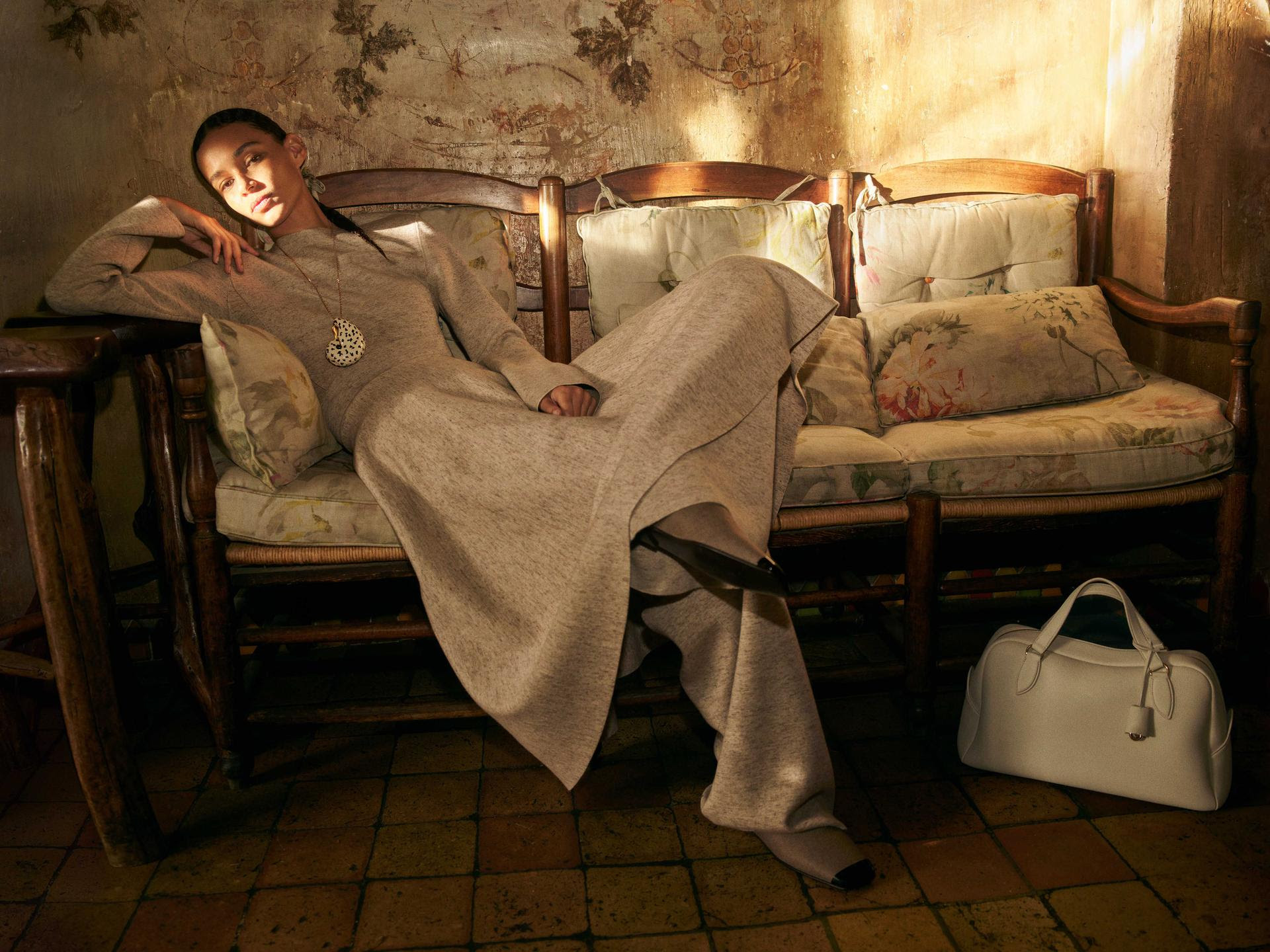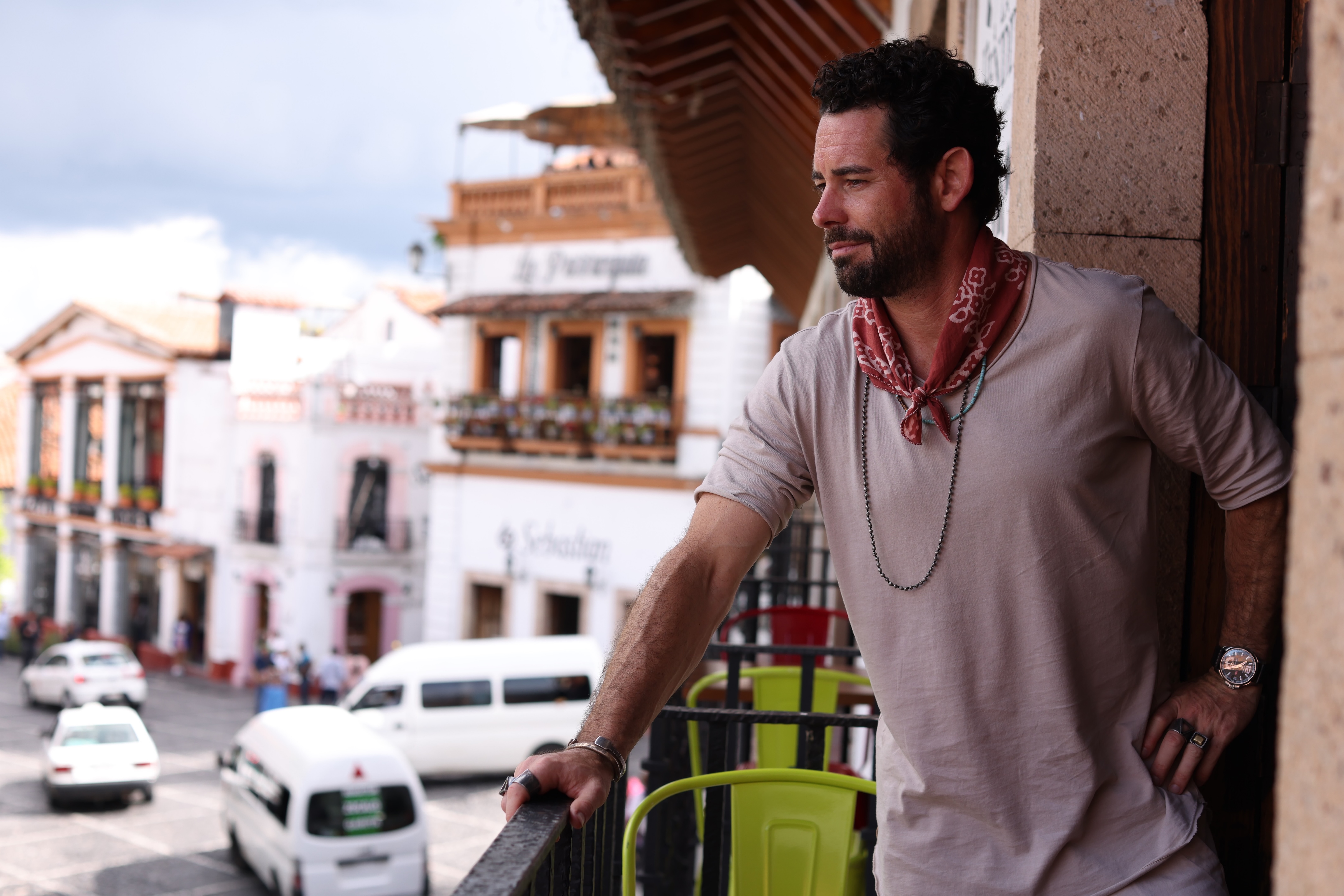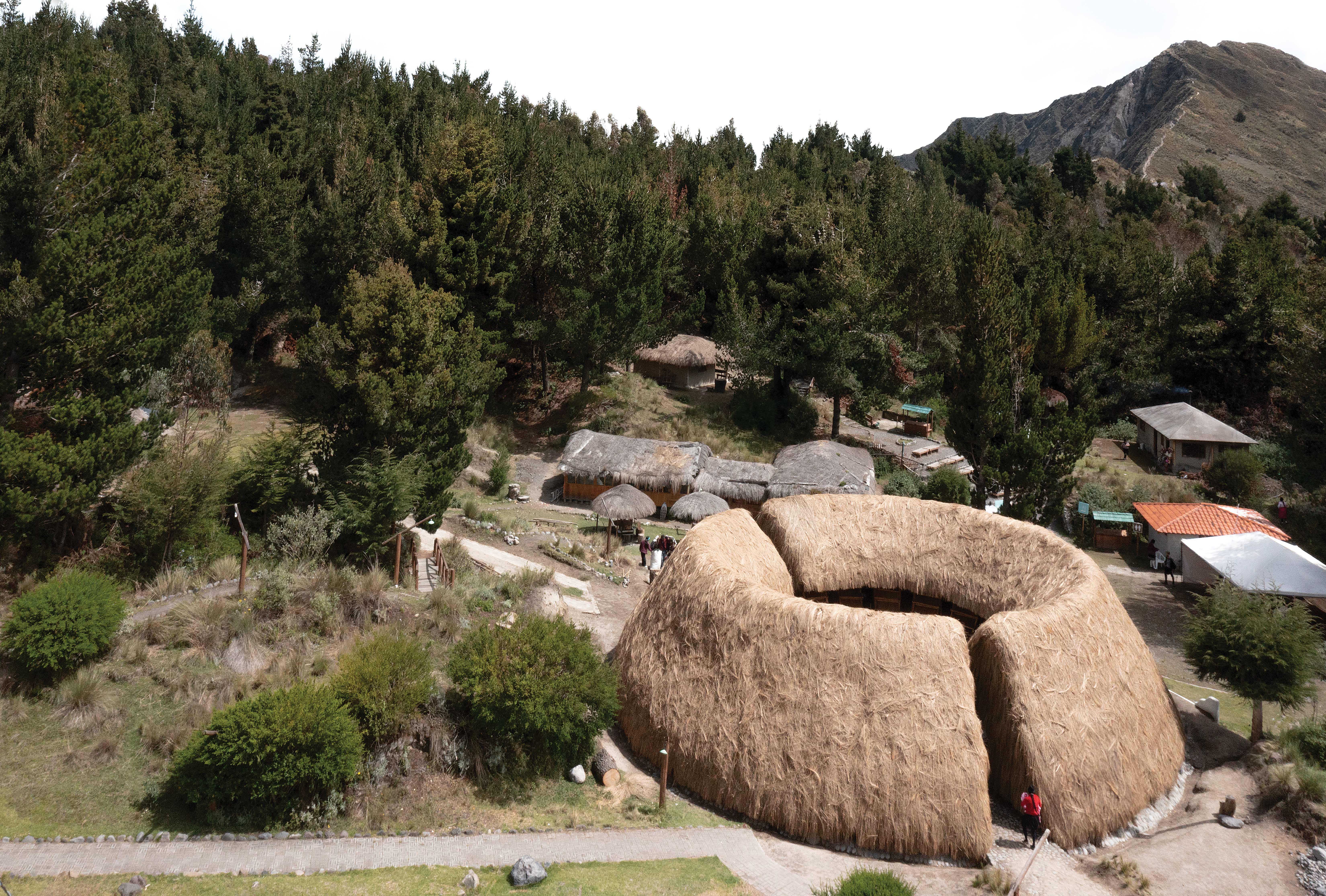Presently, four cylinders made of brass, black Monterrey marble, and white stone lay seemingly motionless on a gallery floor in Mexico City. They compose “Transits and Occulations I,” the centerpiece of _Great Circles_, Elena Damiani’s current exhibition at Galerie Nordenhake. Although sculpturally still, the four cylinders simulate the visual experience of an astronomical eclipse: by circling the cylinders, a spectator can witness light and materiality provoking the sculpture into movement.
I am nowhere to be seen in Mexico City, nor is Damiani. Out of my window, big fat raindrops fall on New York as I stare attentively at an image of her artwork on my computer screen. I converse with Damiani over the phone and enviously note birds chirping on her side of the call. She is in her hometown of Lima, Peru, where I envision her sitting with great posture in a sun-soaked room.
“That is why I put the cylinders on the ground,” Damiani explains. Sections cut from the stone are layered with brass, which—much like an eclipse—Damiani harnesses to play ocular tricks on the spectator. “By moving around the sculpture,” she continues, “you can see objects that are obscure, reflective, and have their own light to them,” a revealing of perception’s fickle nature.
Light and darkness is one of many dualisms Damiani rearranges, as her work fearlessly delves into the conundrums that dualities breed. Within every tendril of our conversation, dialectics of fact/fiction, past/present, and virtual/real continuously materialize like some sick philosophical game of Whac-A-Mole. There is one, though, that sits inescapably at the core of Damiani’s work: the personal and the collective.


INSTALLATION VIEW “GREAT CIRCLES I-IV” 2019, GALERIE NORDENHAKE, MEXICO. COURTESY OF THE GALLERY AND THE ARTIST. PHOTO BY BRUNO RUIZ.
Born in 1979, Damiani was raised in Lima, Peru, a city rich in geological history. “I collected stones on the coast of Lima when I was little. Wherever I dug I found something ancient. I remember every time I found an obsidian, I was convinced it was the tip of an arrow. I created stories around these objects.” For the past decade, Damiani has transformed found material of a geological, archeological and cartographical nature into collages, sculptures, video, and installations. Ruminating on the archaic is a culturally inherited trait. “I had four broken TVs in my basement growing up,” Damiani recalls. Even with two industrial engineers as parents, in a household where logic was the rule, ‘antiquated’ objects still continue to serve purposes beyond the practical.
At the beginning of her career, Damiani was insistent that her work shy away from the personal. “I wanted to be ambiguous, not specific,” she clarifies. After living in London for seven years, Damiani continued collecting every Thursday at Spitalfields Market, where she befriended vendors and cultivated a library of national and geological atlases, and celestial cartographies. “I realized that the work was very much about me,” states Damiani. “And there was no way out of that. But through a personal experience, a collective experience opens up.”
The works in _Great Circles_ are sourced from George Way-mouth’s _The Jewell of Artes_, a 1604 manuscript written in Old English and ornamented calligraphy that diagrams a collection of technical drawings, navigational devices and instruments of war. “I do have a fetish for these old things,” she admits, “but I end up ripping up and defiling their pages.” Albeit in conversation with the historical purpose of the material—the instrumental definition of the object itself—Damiani aims to decontextualize the object from a one-dimensional definition. “I am working with material that was meant to be didactic. However, a material’s specificity can open layers of collective meaning,” she waxes. “I use historical materiality to pinpoint things about the present. My purpose is to understand our position in the world by acknowledging the limitation of human knowledge.”
I call attention to the exhibition’s “Horizon Ring”—an objectively beautiful sculpture composed of Tepeaca marble and brass—that perfectly collapses into itself. “The structure and title remind me of Kant’s _transcendental horizon_,” I volunteer. Then pause. The mere mention of Kant often provokes such melodramatic eye-rolls that are known to transcend space & time, i.e. I can sense them over the phone. But all I hear from Damiani is complete attention. I am reminded of her earlier comment: “I am moved by curiosity of things that I do not understand,” and I now see it was quite genuine. “This is the motor that drives my work: how can I understand what is unknown to me?” she posits. I continue to explain Kant’s theory of the _noumena_. That is, the essence of the things-in-themselves, and how such essences are unknowable to speculative reason, that such understanding lies on the other side of transcendental horizon. I ask pointedly, “Do you believe that there are things-in-themselves? An inaccessible essence of objects?”
“The Horizon Ring” is a direct reference to an _armillary sphere_—an early astronomical device that represented “the great circles” of the terrestrial globe: the horizon, meridian, Equator, tropics, polar circles, and an ecliptic hoop. “They mapped all of these imaginary circles so we could have a point of reference,” Damiani pauses, dramatically. “But a point of reference towards what? All of these configurations are part of a larger intangible system that we will never fully understand.” “The Horizon Ring” is sort of ironic in this way—a representation of our seemingly infallible attempt at grasping the whole truth. “Yes,” she responds, “our understanding of reality is very limited.”
“But if humans are limited by perception,” I logically ask, “do you believe there exists a greater force that can comprehend the intangible—an omnipotent god?” She laughs. “No,” she decisively answers. “But I would like to think that there is a universal force, and that through the exchange of art, science, and philosophy, we can try to understand how this force works. But there is no real escape from our limitations. All we can do is be aware.”


ELENA DAMIANI “HORIZON RING” 2019. TEPEACA MARBLE AND BRASS. 24 X 22 X 2.1 IN. COURTESY OF THE GALLERY AND THE ARTIST. PHOTO BY BRUNO RUIZ.
Damiani seeks to turn little truths into big truths. In reality, she translates the vastness of history into a parcel of truth we can swallow. And then, like a blow-up doll, allows the spectator to inflate the little truth to its original big size, allowing the cultural biases of each person to fashion unique deviations along the way.
The three remaining sculptures in the exhibit add more strata to the conversation of technological obscurity and greater awareness: In “Orbital Resonances,” three celestial objects made of marble and brass dance on slates of volcanic stone fixed on the wall, echoing the chaotic orbits of Pluto’s moons, and while I experience the sculpture virtually, I am still touched by its relatable frenzy; “Transits and Occulations II” hangs vertically on the parallel wall that places the viewer on a horizontal plane, almost begging the spectator to size-up the cylinder’s transformational potential; and “Protractor,” an aesthetically gorgeous version of a beloved analog object.
A series of drawings complete the exhibition and share its name. Inspired by Swedish artist Hilma af Klint, “Great Circles” ground the solidity of the exhibit in a more subliminal space. “I wanted to recreate the gradients of solar energy,” proclaims Damiani. Emulating af Klint’s ability to drape innocence in an undeniable depth, the drawings are technically and emotionally beautiful. “Gradients ask for contemplation,” she tells me. “It is not that often that I use color. I hand-drew every single one with the same box of pencils I have had since high school.” I chuckle with a quiet pride, as though I finally understand an inside joke. “There is a certain point in your practice where you really miss doing things for yourself. Our mind rewards moments that abstract us from the general rhythm of the every day. I missed drawing. The mindfulness of drawing. How the task of coloring erases everything around you.”
The poetic irony does not escape me: that contemplating our existence in the universe demands an oblivion, an inner space where we must forget we are in a universe at all. Nor does the conundrum escape Damiani. It is in these great circles we progress.
 
INSTALLATION VIEW “GREAT CIRCLES I-IV” 2019, GALERIE NORDENHAKE, MEXICO. COURTESY OF THE GALLERY AND THE ARTIST. PHOTO BY BRUNO RUIZ.
Born in 1979, Damiani was raised in Lima, Peru, a city rich in geological history. “I collected stones on the coast of Lima when I was little. Wherever I dug I found something ancient. I remember every time I found an obsidian, I was convinced it was the tip of an arrow. I created stories around these objects.” For the past decade, Damiani has transformed found material of a geological, archeological and cartographical nature into collages, sculptures, video, and installations. Ruminating on the archaic is a culturally inherited trait. “I had four broken TVs in my basement growing up,” Damiani recalls. Even with two industrial engineers as parents, in a household where logic was the rule, ‘antiquated’ objects still continue to serve purposes beyond the practical.
At the beginning of her career, Damiani was insistent that her work shy away from the personal. “I wanted to be ambiguous, not specific,” she clarifies. After living in London for seven years, Damiani continued collecting every Thursday at Spitalfields Market, where she befriended vendors and cultivated a library of national and geological atlases, and celestial cartographies. “I realized that the work was very much about me,” states Damiani. “And there was no way out of that. But through a personal experience, a collective experience opens up.”
The works in _Great Circles_ are sourced from George Way-mouth’s _The Jewell of Artes_, a 1604 manuscript written in Old English and ornamented calligraphy that diagrams a collection of technical drawings, navigational devices and instruments of war. “I do have a fetish for these old things,” she admits, “but I end up ripping up and defiling their pages.” Albeit in conversation with the historical purpose of the material—the instrumental definition of the object itself—Damiani aims to decontextualize the object from a one-dimensional definition. “I am working with material that was meant to be didactic. However, a material’s specificity can open layers of collective meaning,” she waxes. “I use historical materiality to pinpoint things about the present. My purpose is to understand our position in the world by acknowledging the limitation of human knowledge.”
I call attention to the exhibition’s “Horizon Ring”—an objectively beautiful sculpture composed of Tepeaca marble and brass—that perfectly collapses into itself. “The structure and title remind me of Kant’s _transcendental horizon_,” I volunteer. Then pause. The mere mention of Kant often provokes such melodramatic eye-rolls that are known to transcend space & time, i.e. I can sense them over the phone. But all I hear from Damiani is complete attention. I am reminded of her earlier comment: “I am moved by curiosity of things that I do not understand,” and I now see it was quite genuine. “This is the motor that drives my work: how can I understand what is unknown to me?” she posits. I continue to explain Kant’s theory of the _noumena_. That is, the essence of the things-in-themselves, and how such essences are unknowable to speculative reason, that such understanding lies on the other side of transcendental horizon. I ask pointedly, “Do you believe that there are things-in-themselves? An inaccessible essence of objects?”
“The Horizon Ring” is a direct reference to an _armillary sphere_—an early astronomical device that represented “the great circles” of the terrestrial globe: the horizon, meridian, Equator, tropics, polar circles, and an ecliptic hoop. “They mapped all of these imaginary circles so we could have a point of reference,” Damiani pauses, dramatically. “But a point of reference towards what? All of these configurations are part of a larger intangible system that we will never fully understand.” “The Horizon Ring” is sort of ironic in this way—a representation of our seemingly infallible attempt at grasping the whole truth. “Yes,” she responds, “our understanding of reality is very limited.”
“But if humans are limited by perception,” I logically ask, “do you believe there exists a greater force that can comprehend the intangible—an omnipotent god?” She laughs. “No,” she decisively answers. “But I would like to think that there is a universal force, and that through the exchange of art, science, and philosophy, we can try to understand how this force works. But there is no real escape from our limitations. All we can do is be aware.”

INSTALLATION VIEW “GREAT CIRCLES I-IV” 2019, GALERIE NORDENHAKE, MEXICO. COURTESY OF THE GALLERY AND THE ARTIST. PHOTO BY BRUNO RUIZ.
Born in 1979, Damiani was raised in Lima, Peru, a city rich in geological history. “I collected stones on the coast of Lima when I was little. Wherever I dug I found something ancient. I remember every time I found an obsidian, I was convinced it was the tip of an arrow. I created stories around these objects.” For the past decade, Damiani has transformed found material of a geological, archeological and cartographical nature into collages, sculptures, video, and installations. Ruminating on the archaic is a culturally inherited trait. “I had four broken TVs in my basement growing up,” Damiani recalls. Even with two industrial engineers as parents, in a household where logic was the rule, ‘antiquated’ objects still continue to serve purposes beyond the practical.
At the beginning of her career, Damiani was insistent that her work shy away from the personal. “I wanted to be ambiguous, not specific,” she clarifies. After living in London for seven years, Damiani continued collecting every Thursday at Spitalfields Market, where she befriended vendors and cultivated a library of national and geological atlases, and celestial cartographies. “I realized that the work was very much about me,” states Damiani. “And there was no way out of that. But through a personal experience, a collective experience opens up.”
The works in _Great Circles_ are sourced from George Way-mouth’s _The Jewell of Artes_, a 1604 manuscript written in Old English and ornamented calligraphy that diagrams a collection of technical drawings, navigational devices and instruments of war. “I do have a fetish for these old things,” she admits, “but I end up ripping up and defiling their pages.” Albeit in conversation with the historical purpose of the material—the instrumental definition of the object itself—Damiani aims to decontextualize the object from a one-dimensional definition. “I am working with material that was meant to be didactic. However, a material’s specificity can open layers of collective meaning,” she waxes. “I use historical materiality to pinpoint things about the present. My purpose is to understand our position in the world by acknowledging the limitation of human knowledge.”
I call attention to the exhibition’s “Horizon Ring”—an objectively beautiful sculpture composed of Tepeaca marble and brass—that perfectly collapses into itself. “The structure and title remind me of Kant’s _transcendental horizon_,” I volunteer. Then pause. The mere mention of Kant often provokes such melodramatic eye-rolls that are known to transcend space & time, i.e. I can sense them over the phone. But all I hear from Damiani is complete attention. I am reminded of her earlier comment: “I am moved by curiosity of things that I do not understand,” and I now see it was quite genuine. “This is the motor that drives my work: how can I understand what is unknown to me?” she posits. I continue to explain Kant’s theory of the _noumena_. That is, the essence of the things-in-themselves, and how such essences are unknowable to speculative reason, that such understanding lies on the other side of transcendental horizon. I ask pointedly, “Do you believe that there are things-in-themselves? An inaccessible essence of objects?”
“The Horizon Ring” is a direct reference to an _armillary sphere_—an early astronomical device that represented “the great circles” of the terrestrial globe: the horizon, meridian, Equator, tropics, polar circles, and an ecliptic hoop. “They mapped all of these imaginary circles so we could have a point of reference,” Damiani pauses, dramatically. “But a point of reference towards what? All of these configurations are part of a larger intangible system that we will never fully understand.” “The Horizon Ring” is sort of ironic in this way—a representation of our seemingly infallible attempt at grasping the whole truth. “Yes,” she responds, “our understanding of reality is very limited.”
“But if humans are limited by perception,” I logically ask, “do you believe there exists a greater force that can comprehend the intangible—an omnipotent god?” She laughs. “No,” she decisively answers. “But I would like to think that there is a universal force, and that through the exchange of art, science, and philosophy, we can try to understand how this force works. But there is no real escape from our limitations. All we can do is be aware.”
 
ELENA DAMIANI “HORIZON RING” 2019. TEPEACA MARBLE AND BRASS. 24 X 22 X 2.1 IN. COURTESY OF THE GALLERY AND THE ARTIST. PHOTO BY BRUNO RUIZ.
Damiani seeks to turn little truths into big truths. In reality, she translates the vastness of history into a parcel of truth we can swallow. And then, like a blow-up doll, allows the spectator to inflate the little truth to its original big size, allowing the cultural biases of each person to fashion unique deviations along the way.
The three remaining sculptures in the exhibit add more strata to the conversation of technological obscurity and greater awareness: In “Orbital Resonances,” three celestial objects made of marble and brass dance on slates of volcanic stone fixed on the wall, echoing the chaotic orbits of Pluto’s moons, and while I experience the sculpture virtually, I am still touched by its relatable frenzy; “Transits and Occulations II” hangs vertically on the parallel wall that places the viewer on a horizontal plane, almost begging the spectator to size-up the cylinder’s transformational potential; and “Protractor,” an aesthetically gorgeous version of a beloved analog object.
A series of drawings complete the exhibition and share its name. Inspired by Swedish artist Hilma af Klint, “Great Circles” ground the solidity of the exhibit in a more subliminal space. “I wanted to recreate the gradients of solar energy,” proclaims Damiani. Emulating af Klint’s ability to drape innocence in an undeniable depth, the drawings are technically and emotionally beautiful. “Gradients ask for contemplation,” she tells me. “It is not that often that I use color. I hand-drew every single one with the same box of pencils I have had since high school.” I chuckle with a quiet pride, as though I finally understand an inside joke. “There is a certain point in your practice where you really miss doing things for yourself. Our mind rewards moments that abstract us from the general rhythm of the every day. I missed drawing. The mindfulness of drawing. How the task of coloring erases everything around you.”
The poetic irony does not escape me: that contemplating our existence in the universe demands an oblivion, an inner space where we must forget we are in a universe at all. Nor does the conundrum escape Damiani. It is in these great circles we progress.

ELENA DAMIANI “HORIZON RING” 2019. TEPEACA MARBLE AND BRASS. 24 X 22 X 2.1 IN. COURTESY OF THE GALLERY AND THE ARTIST. PHOTO BY BRUNO RUIZ.
Damiani seeks to turn little truths into big truths. In reality, she translates the vastness of history into a parcel of truth we can swallow. And then, like a blow-up doll, allows the spectator to inflate the little truth to its original big size, allowing the cultural biases of each person to fashion unique deviations along the way.
The three remaining sculptures in the exhibit add more strata to the conversation of technological obscurity and greater awareness: In “Orbital Resonances,” three celestial objects made of marble and brass dance on slates of volcanic stone fixed on the wall, echoing the chaotic orbits of Pluto’s moons, and while I experience the sculpture virtually, I am still touched by its relatable frenzy; “Transits and Occulations II” hangs vertically on the parallel wall that places the viewer on a horizontal plane, almost begging the spectator to size-up the cylinder’s transformational potential; and “Protractor,” an aesthetically gorgeous version of a beloved analog object.
A series of drawings complete the exhibition and share its name. Inspired by Swedish artist Hilma af Klint, “Great Circles” ground the solidity of the exhibit in a more subliminal space. “I wanted to recreate the gradients of solar energy,” proclaims Damiani. Emulating af Klint’s ability to drape innocence in an undeniable depth, the drawings are technically and emotionally beautiful. “Gradients ask for contemplation,” she tells me. “It is not that often that I use color. I hand-drew every single one with the same box of pencils I have had since high school.” I chuckle with a quiet pride, as though I finally understand an inside joke. “There is a certain point in your practice where you really miss doing things for yourself. Our mind rewards moments that abstract us from the general rhythm of the every day. I missed drawing. The mindfulness of drawing. How the task of coloring erases everything around you.”
The poetic irony does not escape me: that contemplating our existence in the universe demands an oblivion, an inner space where we must forget we are in a universe at all. Nor does the conundrum escape Damiani. It is in these great circles we progress.


















